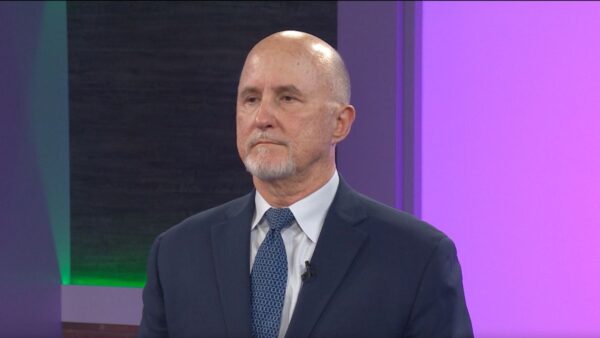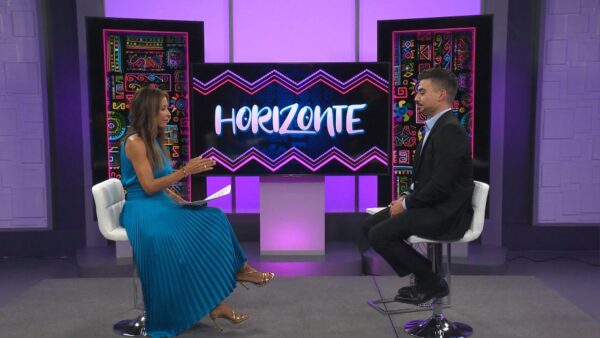The ASU School of Art in the Herberger Institute for Design and the Arts is hosting ‘Beyond the Fence,’ in the Northlight Gallery. The exhibition features the work of four photographers showing the complexity of issues at the U.S.-Mexico border.
Northlight Gallery Director Elizabeth Allen and Emily Matyas, one of the photographers, discuss the exhibition.
Jose Cardenas: There's a unique exhibition coming to the valley. The complexity of issues along the U.S.- Mexico border is captured by images taken by photographers. The exhibition is called "Beyond the Fence." With me to talk about this Emily Matyas, one of the photographers and also here is Liz Allen, the Northlight Gallery director at the ASU Herberger Institute for Design and the Arts. Thank you both for joining us on "Horizonte." Liz, you are both the director and the curator for this particular exhibition. Tell us what you had in mind.
Liz Allen: Well, I was wanting to show the multifaceted issues having to do with the U.S.- Mexico border. It's very much in the minds of Arizonans, the country, and globally, really, and I had become familiar with Emily's work a couple years ago, and another photographer David Taylor, and so the exhibition started to form around their work.
Jose Cardenas: And you included two other artists as well. So that's four photographers who are featured.
Liz Allen: Yes. David Rochkind and Alejandro Cartagena.
Jose Cardenas: One of them from Mexico, Monterey Mexico to be specific.
Liz Allen: Yes, Alejandro Cartagena.
And they seem to have different areas of focus. We're going to be looking at some of Emily's work, focus principally on family, and the impact of immigration in the southern part of Sonora. But tell us about the other three quickly and then we're going to focus on some of Emily's stuff.
Liz Allen: Well, Alejandro's work is concerned with the boom in building, this happening specifically about around Monterey, where he lives.
Jose Cardenas: Which is an industrial city in northern Mexico.
Liz Allen: M-hmm. And how the suburbs have taken over the area, how that's affected the environment, how it's affected the rivers, and also these areas don't actually have electricity, they have -- they're not piped for water, they have to have water tanks on their roofs, so the basic things that we would think that would be there for a community are not there. That's one of his great concerns. David Rochkind is focusing more on the drug war itself, and the violence is his concern, the violence that young people are having to grow up with, and how that affects their communities. And then David Taylor, through funding from a Guggenheim finished a project along the border where he was photographing the border patrol, and their daily activities, and the kind of things they have to deal with.
Jose Cardenas: So a budge of facets, including as we mentioned, Emily's, your focus on some smaller towns in southern Sonora. We're going to be showing some images as we talk. We'll break to comment on specific ones. What were you looking to do?
Emily Matyas: Well, with all the talk about the immigration issue, there was one thing I thought was really left out. There's many things, but the one thing that I thought I could do was to bring in the viewpoint of some of the people who are so personally affected by this. I have a long-time history knowing people down in southern Arizona, and I knew that a lot of them really didn't want to be coming across the border, so I thought, well, I'll go down and talk to them, and if they let me, photograph, and try and bring their story to our side so that then we have a discussion as opposed to just our own viewpoint on this.
Jose Cardenas: And we have a number of pictures that you took of different images in some of these southern Sonora towns. Here's one of two young women. Tell us about that picture are.
Emily Matyas: This is Patricia on the left and her older sister, and they live in a very small town it's outside Ciudad Obregon and they -- their father is gone, he's in the United States, working, and the reason mainly is so that he can put his children through school. Alejandra is -- working to become an engineer, she's going to school in Ciudad Obregon but they don't have the money to do that, so he's gone over to the United States. And that's the thing I have found so much, these people they -- it's just out of desperation, really.
Jose Cardenas: And a pretty consistent circumstance that you ran into was the absence of fathers.
Emily Matyas: Yeah. That's one of the biggest things I would ask the social workers to introduce me to people who had one relative, anybody living in the United States, and most of it was the father, or maybe the son of an older woman, or -- anyway, it was mainly women and children left behind.
Jose Cardenas: And we've got pictures of -- here's a family photo here again, father's not there, it's a mother with her two sons.
Emily Matyas: M-hmm. Right. She actually has three sons, the third did not want to be photographed, which is fine. But that's Lucy, and she has described to me in detail how there used to be work in her village, but now because of drought and modern living, the work has all gone away, and people can't find work, they're destitute, and they are desperate.
Jose Cardenas: And I know we have some pictures that we'll be showing that capture some of the more poignant images, for example, these angels' wings.
Emily Matyas: Oh, yeah. Well, that's in a church in another outlying village, farther from the city. And I just asked to see the church was it -- because it was such a prominent part of the town. It was totally empty, they didn't even have any pews, but they did have a room in the back with props that were used for the Christmas pageant. And so these wings were left over. That's a little girl who wore them in a Christmas pageant. She's 5 years old. And she -- I just asked her to put them on and make a photograph, and how it turned out was that the wings are broken and tattered, and she standing in a corner, and to me it meant that she has a lot of potential, but she doesn't have a lot of means to do it.
Jose Cardenas: And her father also --
Emily Matyas: yes.
Jose Cardenas: Not there.
Emily Matyas: Most of the families in that village have no fathers. There's no fathers.
Jose Cardenas: Liz, what do you think will be the reaction of people when they go through this exhibit? It hasn't opened yet, but it will. How long will it be run something at ASU.
Liz Allen: It will be a month.
Jose Cardenas: Specifically what location?
Liz Allen: At Northlight Gallery, and it's near the art building, on the intersection of fourth and Tyler malls, and it will be running through the month of March.
Jose Cardenas: What do you hope people will get out of this? Because you and I talked off camera, you don't have a segment devoted to Emily's work and a segment to David's, or -- have you them mixed up. What are you trying to accomplish?
Liz Allen: I wanted to interweave the images together, to try to tell a more complicated story. To get people to think about how these lives interact. Not only the lives of the people photographed, but the photographers as well. And how they've committed their resources, their time, their energy to getting this story out and to communicating with us. And my intention was just to make people think. We have a very diverse population at ASU, people from countries all own the world, and I think it's important for us to look at these complex issues in a greater perspective.
Jose Cardenas: Now, this week saw the passage at least out of committee, of some rather will aggressive to put it politely, anti-immigration measures. Do you think that's going to impact the size of the crowd or the attitude of the people who will be going through there?
Liz Allen: Possibly. I hope to draw a large crowd. We also have a department of transporter studies at ASU, and I hope that they get involved with the process.
Jose Cardenas: Now, we're going to see some of the pictures from some of the other artists at the end of the interview and before we start the next, but you have one sample, not necessarily in the exhibition but from David Taylor here.
Liz Allen: Yeah. This is a book that he published with radius books as the publisher, and he photographed the monuments along the border. And so this is a series of images.
Jose Cardenas: The significance of the monuments -- it.
Liz Allen: Marks the border. You can see we have one that shows some Disney characters who have been painted on the Mexico side, and here's another one, the fence that's out in the desert area.
Jose Cardenas: And to you this signifies the irony of almost a love-hate relationship with the United States and Mexico as people go back and forth across the border?
Liz Allen: Yeah. And the images of the Disney characters is another picture by David Rochkind of the princesses from Disney movies, and there's a young woman in the image with pigeons flying up, and I wanted to link that to Emily's photograph of the wings also. It represents these dreams that these people have, and this idea that we hold so dear of the American dream, and the opportunity to better yourself and better your life. And your children's lives.
Jose Cardenas: Emily, we're almost out of time. What is it that you hope as an artist to convey in the images that have you in this exhibition?
Emily Matyas: M-hmm. Well, what I would hope would be that the viewer would look at these and have -- I'm trying to promote this gaze between two different countries, so the viewer can look and see something of themselves in someone who lives on the other side of the border.
Jose Cardenas: And you'll know that you've accomplished that when you talk to people there, or --
Emily Matyas: Yeah. Hopefully when I talk to people there, or hopefully when there's more discussion about what can be done to promote the well-being of people on both sides of the border.
Jose Cardenas: Well, we'll see what happens soon I guess, because it starts soon. Thank you both for joining us on "Horizonte."
Elizabeth Allen:Director, ASU School of Art Northlight Gallery;Emily Matyas:Photographer;




















